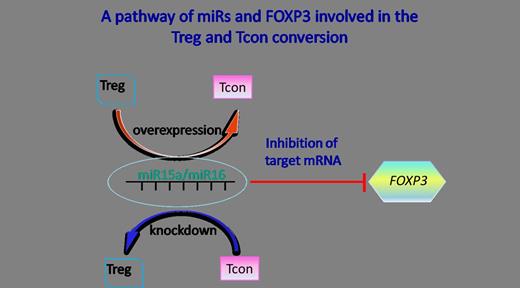Abstract
The exact mechanism of action of Umbilical cord blood (CB) derived regulatory T cells (Tregs) in the prevention of graft versus host disease (GVHD) remains unclear. Based on the selective overexpression of peptidase inhibitor 16 in CB Tregs we explored the related p53 pathway that has been shown to negatively regulate microRNA 15a and 16 (Fabbri, JAMA, 2011). We systematically evaluated the expression of miR15a/16 in CB Tregs (CD4+25+127lo) and compared it to CB derived conventional T cells (Tcons) (CD4+25-127hi). CB Tregs and Tcons were isolated using CD25 based magnetic selection and were ex-vivo expanded for 14 days in the presence of IL-2. Total RNA was reverse transcribed with microRNA-specific primers using a TaqMan® microRNA reverse transcription kit. Differences in miRNA levels were compared with the Student’s T-test. Fisher exact and χ2 tests were applied to categorical variables. Lentivirus based transduction was performed in CB Tregs and CB Tcons for the purpose of miR15a overexpression (OE) and knockdown (KO), respectively. Firefly and Renilla dual luciferase report system were employed to investigate the interaction between miR15a/16 and FOXP3. In order to generate the 3′ UTR mutant construct (3′UTR-del), seed regions were deleted using the QuikChange site-directed mutagenesis kit according to the manufacturer’s protocols (Agilent) and designated as FOXP3 del. We found significantly lower levels of miR15a and miR16 in CB Tregs when compared to CB Tcons (p=0.002 and p<0.001, respectively). As a positive control, miR21 was overexpressed in CB Tregs when compared to CB Tcons (p=0.005). No difference was seen in the miR15a/16 expression between CB Tregs and peripheral Blood Tregs. In a xenogeneic GVHD mouse model, lower levels of miR15a/16 were also found in the circulating CD4+ cells of Treg recipients which correlated with their preservation of phenotype, better GVHD score and overall survival. OE of miR15a/16 in CB Tregs inhibited FOXP3 and CTLA4 expression and led to partial reversal of Treg mediated suppression in an allogeneic mixed lymphocyte reaction (MLR) (p=0.005 and p=0.00001, respectively). OE miR15a/16 also led to reversal of FOXP3 demethylation in CB Tregs. Furthermore, KD of miR15a/16 in CB Tcons led to increased expression of FOXP3 and CTLA4. miR15a/16 KD CB Tcons were able to suppress the proliferation reaction in an alloMLR. Using luciferase based mutagenesis assay, FOXP3 was determined to be a target of miR15a/16 at binding site 1: GTGGTTCTAGACACCCCCTCCCCCATCATA (forward) and GTGGTTCTAGAGGC TCTCTGTGTTTTGGGGT (reverse) and binding site 2: GTGGTTCTAGACCTACAC AGAAGCAGCGTCA (forward) and GTGGTTCTAGAGATCAGGGCTCAGGGAATGG (reverse). This is the first report of identification of FOXP3 as a direct target of miR15a/16 and we propose miR15a/16 as a mechanism involved in the checkpoint of CB Tregs and Tcons (Figure 1). Further study of miR15a/16 pathway can be helpful in better understanding of Treg function.
Shah:Celgene: Membership on an entity’s Board of Directors or advisory committees, Research Funding. McNiece:Proteonomix Inc: Consultancy.
Author notes
Asterisk with author names denotes non-ASH members.


This feature is available to Subscribers Only
Sign In or Create an Account Close Modal